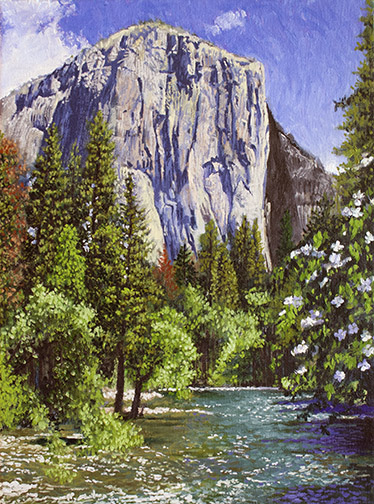
This is the monumental rock face in Yosemite that Alex Honnold just solo free climbed (Saturday June 3, 2017) in under 4 hours, breaking all previous records. Kudos to Alex. He may be able to climb it, but can he paint it?
I recently finished this painting in my studio, beginning it, on location, during my Yosemite Renaissance artist in residence stay in the park from May 8 – 14, 2017. To be more precise I began this piece, plein air, on the Saturday of my stay, May 13.
I’ve covered the details surrounding the discovery and difficulties encountered in actually getting setup to paint this site in earlier blog posts: Artist in Residence – Day 4, Day 5 and Day 6, if you’re interested. This post is going to be about the actual painting of that monument.
Through trial and error, I’ve come to the conclusion that the best way, for me, to paint plein air is by using the Indirect Painting method. I’ve tried the Direct Painting approach, most recently in the first few days of this residency, but I’ve always been unhappy with the results. In a nutshell, with Indirect Painting an underpainting, usually monochrome, is done before the full color over-painting is begun. By contrast, Direct Painting starts laying down full color from the get-go.
Here’s why I believe Indirect Painting is best. All painting should start with the darks in the scene and progress through the medium values, ending with the lights. And always, the painting should be worked as a whole. The darks are the armature that hold the entire painting together. Get your darks right and your halfway home with the entire painting. You want to work the painting as a whole, because each color or value you add, changes what’s already there, through juxtaposition. If you slave away on this corner or that, rendering to finish, while leaving the rest of the canvas untouched, you’re setting yourself up for a fall. When you add the rest of the color you’ll learn it changes what you so diligently rendered up front. The colors in that early rendering no longer look correct.
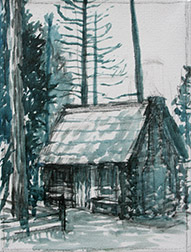
The light changes quickly, when you’re painting outside, so it’s important to establish the lighting quickly. You can always choose to adapt to the light later in the day, if you like that better than what you started with, but if you don’t get that first lighting scheme down quickly, you’ll have no record of it. With direct painting you’re losing valuable time, mixing this color dark for the tree trunks, that color dark for the foliage, another dark color for the water, etc., all in an attempt to get all your darks down quickly. By using the Indirect Painting method, I mix one color and using turpentine washes (50% painting medium, 50% solvent) lay down all my darks quickly. I’ve speedily established the morning’s lighting scheme and I’m ready to start painting in color.
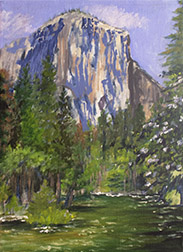
So after completing my darks underpainting, I spent the rest of the day laying down opaque color with confidence, knowing I had a darks map of the morning’s lighting conditions. In fact, I could concentrate on the colors of medium and light value first, knowing my underpainting darks were there and that I could change them to their proper colors later, if necessary. You may have noticed that my underpainting is ink blue. I find most outdoor shadows are cool, so the color is a good choice for plein air painting. When I do an underpainting of an indoor subject, like a still life or portrait, I’m more likely to use the warmer, burnt umber.
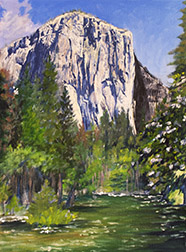
Back in the studio, working from reference photos I’d taken that day out in the field, I tore into my original plein air painting, adding more detail, at a more relaxed pace. Since so much of the painting was resolved that day, on location, I felt comfortable concentrating my effort directly on the rock, rather than working up the detail in the entire painting gradually. El Cap was the hero here, I needed the confidence that it was working, before I could relax and work up the supporting cast. I also reworked the sky at this time. I liked the color and clouds in one of my later photos better than what I’d painted on location.
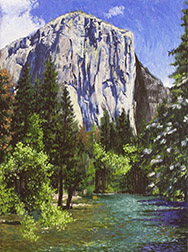
Comfortable that El Capitan was pretty much resolved, I started detailing the rest of the painting, working on it as a whole now: trees, bushes, river, dogwood, etc. You’ve probably noticed I like color. I carefully inspect every subject for less than obvious color I can enhance, the blues in the shadows on the right, cast on the river by the trees, for example. I also put back the aqua in the Merced River that I remembered being there in the morning, but missing when I finally got to the river at the end of the day. Unfortunately, your darks underpainting doesn’t help you remember what color things were when you started. There’s a special advantage gained by, at least, starting your paintings on location, that’s lost when you paint from photos exclusively: color memory acquired through actually being there.
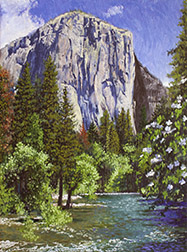
Getting close to the finish here. Added more light values to the foliage. Notice how just adding the white water brings the river to life, bubbling and churning. Where I had a pond before, we’re now looking at the Merced River. I find it’s worth taking the time to place these small shape accurately, even if painted loosely, they can make the difference in whether your subject appears static or alive. I also added more detail to the dogwood here.
With just another session or two, I arrived at the finish (shown at the top of this post) : my final level of light values and a little necessary nit-picking here and there. Just in time for Alex to scale it!

Such a fabulous painting all a around!! Even a few brown dead tress which are everywhere up there now! Driving thru Mid Pines out of Mariposa on way up to Yosemite , it was scary to see so many brown Ponderosa pines along and inland from the road! Seems like a likely inferno at some unfortunate point!
Your wonderfully written detailed blogs are great teaching tools…so interesting to read! Kudos and many thanks!!
Thank you, Carolyn, for your kind words. I live in the town of Oakhurst, these days, along the southern entrance (Hwy 41) into Yosemite. Watching the trees die year after year, due to drought making it possible for the bark beetles to do their worst, has been breaking our hearts up here. Luckily, record rains appear to have halted their handiwork. We lost a giant 400 year old Ponderosa Pine on our street, due to this, last summer. The forest service and private contractors are doing their utmost to down the dead trees and truck them out of the area, beginning with those that pose the greatest danger, close to highways. Now that the tree devastation is, hopefully, halted, it’s a small consolation, if, in fact, it’s a consolation at all, that they add color a painting.
I’ve been the fortunate recipient of a very good art education and countless opportunities, over the years, to practice and hone my skills, the least, I feel, I can do is share any information that has been generously passed on to me.